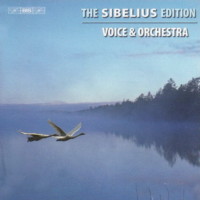
A Special Quality
Music by Sibelius
for voice and orchestra -
recommended by
ROBERT ANDERSON'Throughout the set BIS has maintained the high standards ...'
|

|
Global warming seems to bring increasingly icy draughts from the north, which should do nothing but brace us for tough times ahead. If it also places Sibelius more centrally in our concert halls, we should be similarly reinvigorated, and spiritually toughened against the increasingly effete demands made by demos on our hearing. It matters not a rap how many bottles of alcohol went to the creation of a Sibelian masterpiece, except only that the constant need for cash certainly reduced their number. Kullervo of 1891-2 is the first of them, and it is evident that the young Sibelius, having sat near Bruckner at a chamber concert in Vienna and heard the revised version of the Third Symphony, ranked him very highly at the time.
Sibelius originally planned the choral movements of Kullervo for mixed choir, but decided in the end that only men could face up to the fact that, despite Wagner's Siegmund and Sieglinde, the girl Kullervo invites on to his sleigh and subsequently seduces turns out to be his sister. This is the most extended and most powerful movement of the work.
Listen -- Sibelius: Kullervo and his Sister (Kullervo Op 7)
(CD 1 track 3, 1:16-2:57) © 1984-2007 BIS Records AB
It caused surprise and delight that Sibelius addressed the choir for the first performance in Finnish. Indeed he was already closely allied to the movement that increasingly resented Russian heavy-handedness in the handling of its Scandinavian province.
It might seem the more incongruous, therefore, that Sibelius wrote an extended cantata in 1896 for the coronation of the ill-fated tsar Nicholas II. Nicholas was married to a close but ill-advised favourite of Queen Victoria, and a crowd stampede at their first appearance in Moscow had resulted in many deaths. The cantata was first performed in the Great Hall of Helsinki University, where Sibelius had begun to teach. He blamed the work's failure on drunken improvisations by the tuba player, though the score contains no part for the instrument. Local feeling was more than enough to account for a cool reception.
Listen -- Hail, young prince ... (Cantata for the Coronation of Nicholas II)
(CD 2 track 9, 0:02-1:50) © 1984-2007 BIS Records AB
At the same time Sibelius was at work on his only completed opera, a one-act work lasting little more than half an hour. Indeed the first performance took place within a week of the cantata's première. That Sibelius was under considerable pressure is clear from accounts by one of the leading characters, who visited the composer to make the obvious point that it would be more practical for the cast actually to see their music rather than guess it. The story concerns a virtuous maiden abducted by a wicked bailiff and eventually released by the generous châtelaine. Here the maiden rejoices in her final freedom.
Listen -- Now I am free ... (The Maiden in the Tower JS101)
(CD 3 track 10, 0:00-0:54) © 1984-2007 BIS Records AB
One of Sibelius's finest songs, Autumn Evening, is characteristic of the composer's attitude to nature, in which a lonely wanderer is overawed by the majesty of the scene around him. Originally written in 1903 with piano accompaniment, the song appeared in two instrumental versions the following year. Cortot conducted the full orchestral score in 1905, but the arrangement for strings only was first heard a century later. Both versions appear in the set. With two symphonies already behind him, Sibelius is magisterial in the full score; but the string accompaniment has a special quality of its own.
Listen -- Höstkvöll (Op 38 No 1 for voice and string orchestra)
(CD 4 track 10, 0:02-1:11) © 1984-2007 BIS Records AB
Throughout his career Sibelius orchestrated many of his most successful songs. Indeed the last piece in this set is a version he made in 1957 not long before he himself died of Shakespeare's Come away, Death. A particularly successful example is Sunrise, written in 1902, and scored for full orchestra at the very end of 1913. In this case the solitary observer of nature's wonders is a knight in armour.
Listen -- Sibelius: Soluppgång Op 37 No 3
(CD 5 track 8, 0:02-0:50) © 1984-2007 BIS Records AB
Throughout the set BIS has maintained the high standards of research (witness Andrew Barnett's admirable booklets) and performance we have come to expect and eagerly anticipate for the future in this superb venture.
Copyright © 8 February 2009
Robert Anderson, Cairo, Egypt
 BUY CLASSICAL CDS ONLINE
CD INFORMATION: THE SIBELIUS EDITION - VOICE AND ORCHESTRA
BUY CLASSICAL CDS ONLINE
CD INFORMATION: THE SIBELIUS EDITION - VOICE AND ORCHESTRA
| 
